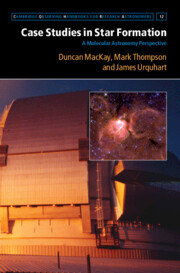Book contents
- Frontmatter
- Dedication
- Contents
- Preface
- List of Acronyms
- Part I Introduction
- Part II Low-Mass Star Formation (LMSF)
- Part III High-Mass Star Formation (HMSF)
- 6 Two HMSFR Surveys Using APEX and NOEMA
- 7 Sagittarius B2
- 8 G29.96 ˗0.02 in W43
- 9 Orion BN/KL
- Part IV Ionisation
- Part V Photodissociation
- Part VI External Galaxies
- Appendices
- List of Research Journal Abbreviations
- References
- Chemical Index
- Subject Index
7 - Sagittarius B2
from Part III - High-Mass Star Formation (HMSF)
Published online by Cambridge University Press: 11 April 2023
- Frontmatter
- Dedication
- Contents
- Preface
- List of Acronyms
- Part I Introduction
- Part II Low-Mass Star Formation (LMSF)
- Part III High-Mass Star Formation (HMSF)
- 6 Two HMSFR Surveys Using APEX and NOEMA
- 7 Sagittarius B2
- 8 G29.96 ˗0.02 in W43
- 9 Orion BN/KL
- Part IV Ionisation
- Part V Photodissociation
- Part VI External Galaxies
- Appendices
- List of Research Journal Abbreviations
- References
- Chemical Index
- Subject Index
Summary
Sagittarius (Sgr) B2 is the most massive star-forming region in the Galaxy and the canonical HMSFR with probably the richest source of molecules detected to date, not least in the number of COMs recorded. The consequences of a variable and higher-than-standard cosmic ionization rates in this region close to the Galactic centre are discussed. They are seen to have a complex effect on COMs chemistries, offering both an unusual test bed for chemical evolution theory, while not being conditions representative of more widely observed HMSF cores. The particular case of cyanides and isocyanides stands out, and modelling that uses enhanced but extinction-dependent CR ionization rate brings best agreement between model results and observations. Nonetheless, the modelled column densities of some species are much lower than observed, and the physical structure profile of the regions appears to be responsible.
- Type
- Chapter
- Information
- Case Studies in Star FormationA Molecular Astronomy Perspective, pp. 124 - 133Publisher: Cambridge University PressPrint publication year: 2023

